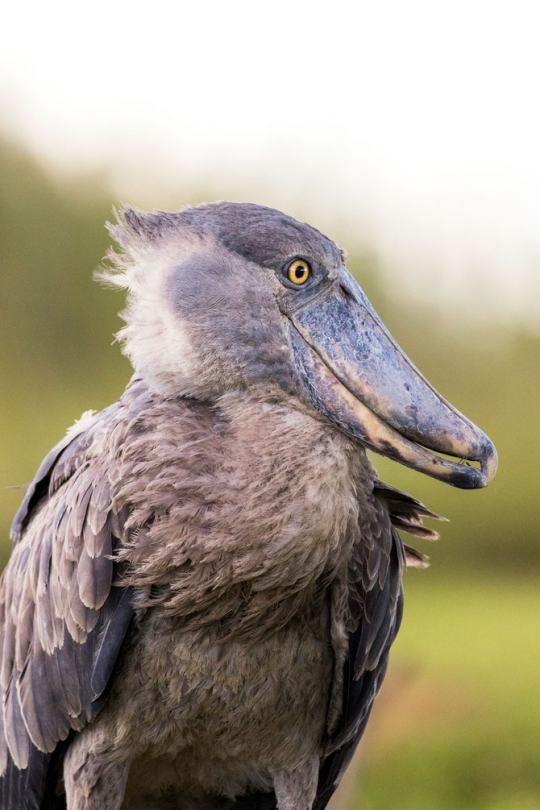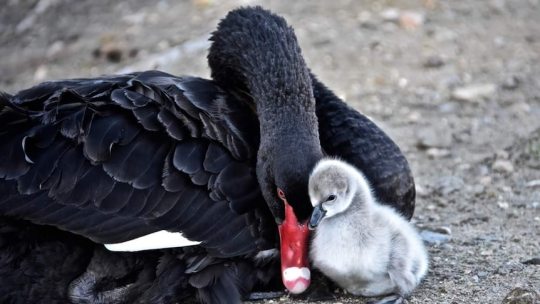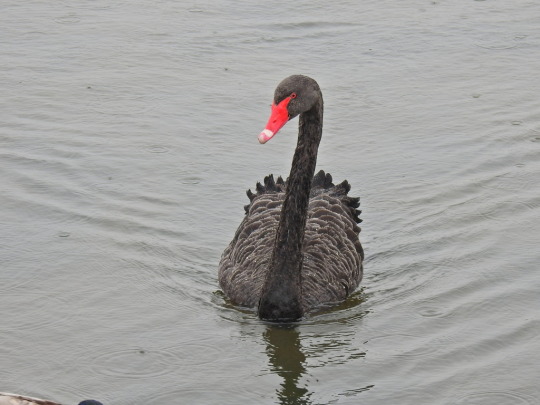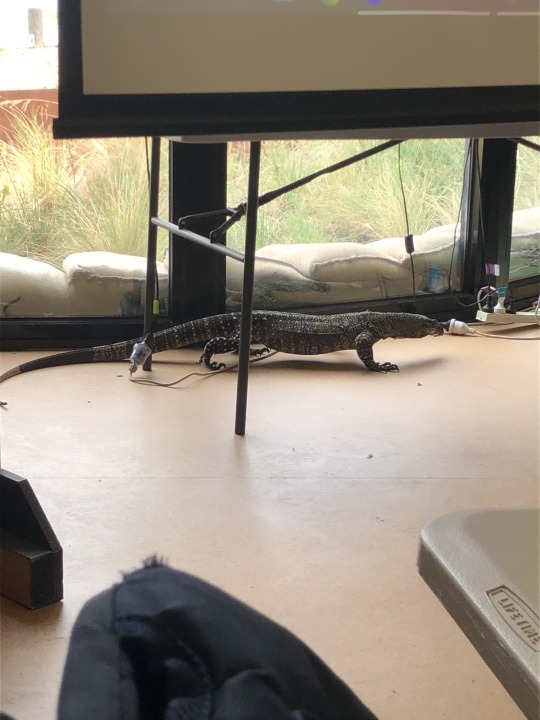#Freshwater Birds
Explore tagged Tumblr posts
Text



A Shoo-in Shoebill Stork
The shoebill stork, also known as the whalebill stork or Balaeniceps rex is in fact not a stork at all, but a long-legged wading bird belonging to the family Pelecaniformes. This species can be found in the central African tropics, from southern Sudan to northern Tanzania. Within this range, they mainly inhabit freshwater swamps and dense marshes, particularly those with deep water large reed beds.
Balaeniceps rex is often referred to as a dinosaur among birds due to its fearsome appearance. The average individual stands 1.1-1.4 m (3.6-4.5 ft) tall and has a wingspan of 2.3 to 2.6 m (7.5 to 8.5 in). However, adults are quite light, weighing only 4 to 7 kg (8.8 to 15.4 lb). Males tend to be larger than females, but otherwise the two sexes look identical. Adults have dark grey plumage with a lighter belly and darker wings. Their most striking feature is their beak, which is extremely large and can be said to resemble a wooden show (hence the name).
The shoebill's beak is very useful for catching its primary prey: fish. B. rex consumes a variety of species, including lungfish, catfish, and tilapia, as well as non-fish items like water snakes, frogs, turtles, mollusks, and even young crocodiles. Shoebills typically stalk their prey, or stand perfectly still and wait for their prey to come to them, before quickly snatching it up and decapitating it with the sharp edges of their beaks. Because of their large size and strong bills, adults are seldom prey for other animals, and they defend their nests fiercely from predators like snakes and other birds.
Outside of the breeding season-- and even during it-- shoebills are extremely territorial. Not only do they chase potential predators away from their nests, both males and females will fiercely defend their territory from other shoebills.
Breeding begins in the dry season, typically in in May, and lasts until about October. Once a male and female form a pair, they remain together for the duration of the mating season. They build a nest from floating vegetation, and 1-3 eggs are cared for by both parents; in addition to being incubated for warmth, one parent may also occasionally pour a beak-full of water over the eggs to keep them cool during the hot summer day. The eggs hatch about 30 days after being laid, and young are fed continuously-- though usually only one chick survives to adulthood. At 125 days old they become fully independent and leave to establish their own territories. The average individual can live up to 35 years in the wild.
Conservation status: The IUCN lists the whalebill stork as Vulnerable. Current wild population estimates sit at about 5,000-8,000 individuals. Primary threats include poaching for the zoo trade and consumption, habitat destruction, and pollution.
If you like what I do, consider leaving a tip or buying me a kofi!
Photos
Santiago Caballero Carrera
George Amato
Mana Meadows
#shoebill stork#Pelecaniformes#Balaenicipitidae#wading birds#birds#wetlands#wetland birds#freshwater fauna#freshwater birds#africa#central africa#animal facts#biology#zoology#ecology
168 notes
·
View notes
Video
youtube
Wonderful Black Swans | Strange Sounds Of Swans | Call Of Swans | Mysor...
#youtube#Animals#Birds#Water Birds#Freshwater Birds#Swans#Black Swans#Mysore Zoo#Birds In Mysore Zoo#Black Plumage#Red Bill#Strange Call#Black Feathers#Black Wings#Webbed Feet#Long Flexible Neck
2 notes
·
View notes
Text

Some coast striker concept doodles, mostly to showcase their weirdo double tongue + i love drawing teeth. Also whelps are see through when they hatch, most lose this quality as they grow, but a few (especially in the Deepwater) keep their translucency well into adulthood.
A small fun fact, many humans call coast strikers "grinning deaths" as their toothy snarls can look like a grin to a person. Given their amount of teeth and their two tongues, other AshWings can find them a bit unsettling
#wings of fire#wof#ashwing#dragons#art#oh yeah remember those region variation drawings i made? im dividing the coast into three regions: the deepwater (open ocean/seabed)#the saltwater (the coastal cliffs) and the freshwater (more inland in the peninsula lots of#wetlands and rivers and lakes. kinda like everglades and mangroves in some areas#however im not sure about the eggs. hmmmm#bc its like this OR regular eggs with an almost conical shape which i believe is common in cliff birds? so the eggs spin on the same place#instead of out of the nest and falling to their doom
423 notes
·
View notes
Text

Four culturally significant aquatic birds in Imperial Wardin- the skimmer gull, the albatross, the reed duck, and the hespaean.
The skimmer gull is a small seabird, distinguished by bright red beaks and a single, trailing tail plume. These are sacred and beloved animals with a long history of symbiosis with local fishers. They will intentionally attract the attention of fishermen, bringing them to shoals of fish that are too deep below the surface for the birds to reach. They then will snatch fish fleeing or caught in the nets, and will often be directly fed by their human assistants in an act of gratitude. They benefit tremendously from their sacred status and a taboo against killing or harming them, and can become absolute food-stealing menaces in seaside towns and cities.
The albatross is a seasonal visitor to the region, with this population migrating to small rocky islands in the White Sea to breed. The specific species occurring in this region is on the smaller side, and has a pale pink beak and soft orange legs. Albatrosses are common characters in regional animal folktales (usually as foolish, romantic types), and sometimes appear in tales as shapeshifters, usually turning into young women who have tumultuous affairs with lonely sailors.
Skimmer gulls and albatross are the most sacred animals of Pelennaumache, the face of God which looks upon the ocean, the winds, storms, maritime trade, fisheries, and broader concepts of luck and the infliction and deflection of curses. Killing either of these birds is considered to bring about disastrous bad luck (unless in the context of a proper sacrifice, most commonly in rites to bless ships and/or sailors with good winds and against ill fortune). The eggs of skimmer-gulls are free game and considered delicacies, while the preciousness of the albatross' single egg clutch is recognized and their consumption is generally discouraged (this isn't to say it doesn't happen).
Feathers of rightly sacrificed albatross and skimmer gulls are minor holy relics (ESPECIALLY gull tail plumes), and considered to be the ultimate good luck charm. The fortuitous find of a shed feather can also impart good luck and can be very valuable (the birds are sometimes poached for their feathers, though fears of the consequences are enough that this poaching is limited in scope). You will often see wealthier people wearing the feathers in hats and headdress, and any seafaring vessel worth its salt should have at least one aboard.
Both birds are evoked in the apotropaic Skimmer-Woman motif (in practice it generally has albatross characteristics, though is sometimes depicted with the tail plume of the gull).
The hespaean is a very unusual bird with two distinct species native to the region, one found exclusively in the western Black river system and its estuaries, and one found in the eastern Brilla and Kannethod river systems. They have very small pointed teeth in their bills, a trait virtually unknown outside of the flightless, beakless classes of birds (most prominently qilik). Their wings are vestigial and virtually nonexistent (with only two bony spurs remaining). These birds are almost exclusively aquatic and do not normally emerge onto land (they cannot walk upright at all, and must push themselves on their bellies). The legs of the Black river hespean develop blue pigmentation from their diet (the brighter the blue, the better fed and healthier the bird), which are waved above the surface during elaborate courtship displays. Both species are known for their haunting, warbling cries (very much like a loon, but more of a howling noise that develops into a shrill warble).
Hespaean build their nests in dense beds of reeds or small, vegetation-heavy river islands that provide some protection from predators. They raise their young during the height of the dry season (when more nesting surfaces are available and they can feed their young with more concentrated fish populations), which is an image of hope and resiliency during harsh dry times and the promise of the river's eventual bounty.
It is known that hespaean used to be caught as chicks and raised to help people catch fish (with ropes around their necks to prevent them from swallowing their catch). This practice is now very rare in the Imperial Wardi cultural sphere (mostly still practiced by the Wogan people along the Kannethod river, to whom these birds are also venerated animals) and has been largely replaced with the import of domesticated cormorants from the Lowlands to the southeast (which are more easily trained and can Usually be trusted not to attempt to swallow their catch).
These birds require large rivers that flow year round and have healthy, dense fish stocks. The population is in decline and they are now relatively rare, largely due to development and overfishing around rivers (and on a much larger timescale, the region becoming drier and water levels more irregular, and their competition with more versatile freshwater tiviit).
The reed duck is a migratory freshwater duck whose coming heralds the beginning of spring growth. They come to mate along rivers and wetlands during the early stages of the wet season, timing their eggs to hatch with the rise in water levels and growth of the vegetation and insects they feed on. They have striking red-brown and gray plumage and very little sexual dimorphism (though the male is somewhat brighter in color and the flesh around the bill turns bright red during the breeding season).
Reed ducks are not domesticated, but some populations are semi-tamed and encouraged to return to certain sites to breed (the riverside temple to Anaemache in Ephennos attracts a massive flock of the ducks every year, continually blessing it with their presence and coating its grounds in droppings), and these stocks are the primary source of sacrificial ducks and coveted shed feathers.
Hespaean and reed ducks are the most sacred animals of Anaemache, the Face of God which looks upon freshwater (particularly rivers), rains, seasonal flooding, fertile earth/seasonal fertility, and wild plant life.
The hespaean is representative of Anaemache as the River Itself and the river as a provider of fish. This association comes down to their all-seasons presence in the rivers, and their population density being a signal of a healthy, well-flowing river with good fish stocks. Lands adjacent to hespaean territory is often the most reliable and bountiful for human subsistence.
The reed duck in particular is the most venerated sacred animal of Anaemache, as representatives of Anaemache as a Face of seasonal fertility. Its coming announces the rains that the region's agriculture relies on, and their cycle of fertility closely matches the cycles of the rivers and that of the earth itself (with their new life emerging with rains, flooding, and new vegetation). There is no prohibition on hunting reed ducks (though proper rites and respect are expected for a sacred animal), and their meat and eggs is said to support female fertility and a healthy pregnancy.
#Hespaean are what I've been repeatedly misspelling as hespiornis up until now (got kind of lazy with the 'hespaean' name but the -an root#is established and makes sense). They're derived hesperornithes that have survived up to the present day but near exclusively as#smaller freshwater birds (their larger marine counterparts have been mostly displaced by tiviit and uhrwal)#Hespaean species exist outside of this region and have a worldwide (but highly fragmented and isolated) distribution#creatures
210 notes
·
View notes
Text
Fish of the Day
Today's "fish" of the day is the common loon!

The common loon, also known as the great northern diver, and great northern loon, scientific name Gavia immer, plays an important role in the marine and aquatic ecosystem. During the summer, the natural range of this bird stretches from Northern Canada, Iceland, and Northern United States. The winter range however is much more widespread, Icelandic birds wintering along the Western coast of Europe and the United Kingdom, where North American birds winter anywhere from Southern Canada to the gulf of Mexico. In the summer, these loons live along freshwater lakes and ponds, breeding in the warmer months. In the winter however, these animals flock to coast lines, bays, inland lakes, and rivers, where they will remain with their chicks until thaw. They can be identified by their distinctive calls, such as, the tremolo, the yodel, the hoot, and wailing. Each of which hold a different meaning and are used to communicate to other looks within an area, or migrating party.

Similar to many other water birds, the common loon is equipped with many adaptations for better fishing. They can dive into water as deep as 60m of depth, searching for fish, as that is what makes up around 80% of their diet. They have large and webbed feet along with powerful legs, which makes them clumsy on land but proficient swimmers. Due to this, the common loon tends to land on the water when it stops flying, and opting to spend as little time on the ground as possible. They prey primarily on fish, with a mouth that can eat fish as large as 10 inches in length, which they swallow whole. When fish are not abundant, they also will eat frogs, crustaceans, small plant matter, and insects. When in a small area, common loons are known for chasing out other water birds in an area before settling in for a season, and are intensely territorial. These birds have few predators, but the list is composed of: bald eagles, which attack adults on occasion, but primarily target chicks and juveniles, sharks, and larger mammals when adults are nesting. Eggs are often taken when the parents aren't looking, and chicks are often eaten by large predatory birds, and large fish.

Common loons are monogamous, and will breed together over multiple breeding seasons, defending over a small or large lake is entirely their territory, which they will chase possible predators and other water birds out of. Only one or two eggs are laid in a season, and the eggs can be anything between pale-brown in coloration with darker spots. incubation of the eggs is 16-70 days in length, and nests are hidden along the lake edge in long grasses, in a quiet area. If a partner dies during a breeding season, the living parent will find another common loon of either sex who is unmated and raise chicks with them. Then after hatching, the chicks will swim nearby or ride along their parents backs, and will begin flying at 11-12 weeks after hatching. After migrating, juveniles and adults no longer interact, and the breeding adults will return to the same territory they claimed the year before. During the breeding summer, non-breeding loons will exist in groups along unoccupied lakes or other water sources. Maternity occurs at around 6 years of age, and this is when loons begin breeding, with an estimated lifespan of around 30 years in total.

Have a wonderful day, everyone!
#Gavia immer#common loon#bird#fish#fish of the day#fishblr#fishposting#aquatic biology#marine biology#freshwater#freshwater fish#animal facts#animal#animals#fishes#informative#education#aquatic#aquatic life#nature#river#ocean#birds
24 notes
·
View notes
Photo

Alright, some more recommendations for the end of #TransRightsReadathon! Here are some standalones by trans authors I've enjoyed. These books mostly fall under the sff umbrella except for Confessions of the Fox which is meta-historical fiction.
They are beautiful, heartfelt, creative explorations of humanity, of our drive for connection, self-understanding, love, and survival. So many of these books look at history, personal, and community, aaaand they are filled with complicated, lovable, engaging characters. All of these books gave me something from a soft place to rest to a new way of viewing the world we live in.
Many of these have trans characters as well, but not all of them. Most of these authors have other books that are also wonderful. Annnd as always there are so many other fabulous books by and about people who are trans.
One Last Stop by Casey McQuistion
An Unkindess of Ghosts by Rivers Solomon
Freshwater by Akwaeke Emezi
Confessions of the Fox by Jordy Rosenberg
All the Birds in the Sky by Charlie Jane Anders
Magic for Liars by Sarah Gailey
Summer Sons by Lee Mandelo
Light from Uncommon Stars by Ryka Aoki
ID: a stack of 8 books on a teal background
#booklr#trans rights readathon#transrightsreadathon#book recs#trans books#queer books#sff books#queer sff books#historical fiction#one last stop#casey mcquiston#an unkindness of ghosts#rivers solomon#freshwater#akwaeke emezi#confessions of the fox#jordy rosenberg#all the birds in the sky#charlie jane anders#magic for liars#sarah gailey#summer sons#lee mandelo#light from uncommon stars#ryka aoki#trans authors
90 notes
·
View notes
Note
I think you're one of my favorite Tumblr accounts even if it's a detector gimmick...
Have you visited the International Crane Foundation? And what's your favorite crane species?
wait I’m someone favorite?? AHHH TYSM!!!!
also I have not visited ICF, but it is on my bucket list!
My favorite crane species would probably be Demoiselle crane, not many people know about them but they’re gorgeous!

#I love all freshwater or swamp birds including ducks tho#I’m just biased towards cranes#not a crane#crane detectors incomprehensible babbling#birds
4 notes
·
View notes
Text
also i figured out what kind of bird i'd be

green herons my beloved 💞
#my posts#i keep thinking what kinda bug or fish or bird i'd be because im an autistic furry#the bug one is really hard for me to answer im not sure yet#i think the fish one is a bit easier. definitely a freshwater fish like a sturgeon bc sturgeon i love you#if it was a saltwater fish though then some lobe finned fish hehehe#also when i say “what ___ i'd be” i mean that as in what my heart feels is right AND likes#i am doing this for fun i am not assigning myself to be a fruit fly sorry fruit fly lovers but theyre not my favorite so i wouldnt be one
3 notes
·
View notes
Text

Northern Hog Sucker
31 notes
·
View notes
Text

Pelicans land in the water of Kerkini lake in Macedonia, Greece. The Dalmatian Pelican, scientifically known as Pelecanus crispus of the Pelecanidae family, is known for its long beak and large throat pouch. The rare species is the largest freshwater bird in the world and has the conservation status of vulnerable and threatened. Kerkini lake is an artificial water reservoir created in 1932 and a very important location for birds around the world as they migrate. It is one of the premier birding sites in Greece
Photograph: Nicolas Economou/NurPhoto/Rex/Shutterstock
#nicolas economou#nature#nurphoto#rex#shutterstock#pelicans#bird photography#kerkini lake#macedonia#greece#dalmatian pelican#freshwater bird
16 notes
·
View notes
Text
Day 41: Old ad for pet supplies

link
--This image is part of the public domain, meaning you can do anything you want with it ! (you could even sell it as a shirt, poster or whatever)--
#art#copyright#free art#open source#public domain#flowers#old advertisements#old art#goldfish#fishes#fish#aquarium#aquablr#freshwater aquarium#pet birds#birdblr#canary
5 notes
·
View notes
Photo



Surprising Black Swans
A popular ornamental waterbird in Europe and North America, the black swan (Cygnus atratus) is a species of swan endemic to Australia and New Zealand. In both their native and introduced ranges they can be found near bodies of fresh or salt water, especially lakes and wetlands with plenty of aquatic vegetation. The species is highly nomadic, and migrate based on yearly rainfall patterns.
Black swans are the second largest swan species, with a maximum weight of 9 kg (19.8 lbs) and a wingspan of 2 m (6.6 ft). Despite being smaller, black swans have the longest neck of any swan. Males, also known as cobs, are slight larger than females-- aka pens. As their name suggests, C. atratus has black plumage, although the flight feathers on their wings are white. The beak is a bright red with a white stripe, thought to be indication of an individuals health and sexual maturity.
Like all swans, the black swan mates for life. In addition to their high fidelity rates, C. atratus is also unique for its high rates of homosexual couples; about 25% of pairings are between individuals of the same sex (primarily males). These mates are known to steal eggs from other nests or form temporary ‘throuples’ with a member of the opposite sex, and some research has shown that homosexual couples are more than twice as likely to successfully raise their young as heterosexual couples.
The mating season for black swans occurs from February to September. While pairs are generally solitary, groups will nest in the same area to increase the chances of finding a mate and decrease the risk of predation. Pairs form when one an individual approaches another and initiates a ritual known as the Triumph Ceremony, in which the individual extends their wings and calls out. If the mate is receptive, they will repeat the gesture, and the pair will then go through a synchronous dance to solidify their pairing. This ceremony is repeated multiple times throughout each breeding season to strengthen the pair’s bond and affirm that between parent and chick.
Females lay 5 or 6 eggs in a clutch, and will alternate incubating them with her partner for 35 to 48 days. After hatching, the young- also known as cygnets- are fairly precocial but will stay in or near the nest for 2 to 3 weeks. It takes up to 6 months for them to completely lose their grey down and grow their adult plumage, though they remain with their family units for up to 9 months. Once they have fully fledged, juveniles join groups of other cygnets for 1-2 years, at which point they become sexually mature.
Black swans can present an intimidating threat to potential predators, so there are few animals that attack fully grown adults. However, eggs and young cygnets can be a target for ravens, birds of prey, and rodents. C. atratus themselves are herbivores and feed primarily on aquatic vegetation.
Conservation status: the IUCN has classified the black swan as Least Concern, and their native populations are stable.
If you like what I do, consider leaving a tip or buying me a ko-fi!
Photos
Damian Shaw
Richard Tommy Campion
Susan Marley via iNaturalist
#black swan#Anseriformes#Anatidae#swans#water fowl#fowl#water birds#birds#freshwater fauna#freshwater brids#lakes#lake birds#wetlands#wetland birds#urban fauna#urban birds#oceania#australia
316 notes
·
View notes
Video
youtube
Jolly Indian Spot Billed Ducks in Kukkarahalli Lake Mysore
#youtube#Birds#Bird#Aquatic Birds#Freshwater Birds#Ducks#Spot Billed Ducks#Indian Spot Billed Ducks#Kukkarahalli Lake#Kukkarahalli Kere#Birds In Mysore
0 notes
Note
please tell me more about your favorite estuary creatures and features 🥺 (<- is largely unfamiliar with this ecosystem) also happy sleepover saturday and many congratulations on graduating 🩷🎉🫂
oo well i think every estuary is different BUT around here we get big patches of cordgrass that essentially form little islands in the bays and salt marshes, under the water line huge colonies of mussels grow in the roots which both help to anchor the grasses and prevent erosion as well as filter the water of pollutants. above the water line a lot shorebirds will nest in the grasses during the summer, especially gulls, and when you're kayaking around you can see them sitting on their nests peeking out of the grass. when the tide is low the sand banks and mud flats are exposed and you'll find a lot of oystercatchers, pipers, and plovers running around and digging for food in the muck. herons and egrets are common too wading around the edges of mud flats and cordgrass islands, and cormorants in the water or on perches. we also have man made raised platforms set up by the state to support osprey populations, and they're really common to see both nesting and flying around hunting. occasionally i'll spy some brown pelicans hanging out on decaying docks or (depending on the location) bald eagle nests in the trees.
underwater we get a lot of blue crabs (shoutout mid atlantic) and horseshoe crabs (largest population in the world!). i luuuv the horseshoe crabs they are such fascinating critters, and completely harmless even though they look kinda freaky and pointy underneath. i've seen fiddler crabs in the mid flats too, and occasionally a sea cucumber or sea snail in the water. sometimes jellyfish; small wispy white ones (idk the species), i don't think they're very harmful but i wouldn't go sticking my feet in the water if they're around either. and my favorite diamondback terrapins, these adorable little turtles with spotted faces that live in and around the estuaries here. i love kayaking around cause you'll just see their little heads poke up out of the water and then disappear a moment later in front of your boat
#sasha answers#kingfisherkink#tyyy#can you tell my whole family is into birds and nature....lol#i spent every summer coming to the shore for a week or two growing up and kayaking the bay remains one of mym favorite activities#I FORGOT TO SAY WHAT AN ESTUARY IS.#basically it's a body of water between an ocean and a river#so there's a mix of salt and freshwater characteristics
8 notes
·
View notes
Text


This is Mr. Lacey, the Lace Monitor at my reptile studies place. He often wanders around the building, so sometimes there is a 2m/6ft long lizard napping under your desk.
God I love Animal Studies lmao
#Lace monitors are also the second biggest lizard in Australia#And this man literally sleeps on the floor and stares at birds through the windows#He’s very sweet though… lovely boy#We have freshwater crocodiles here too just thought you should know that… their names are Leo and Cleo#Australia moment jesus christ#lizard#reptile#Reptile wednesday
11 notes
·
View notes
Text
saw a buuunch of swans and ducks n other birds at the beach
#like all of the left side of the beach was swarmed with birds lol#i thought swans/ducks prefered freshwater...do they also like a nice day out in the beach#the tide was out/low faraway or whatever#hope they had fun#catching and eating crabs or whatever
3 notes
·
View notes